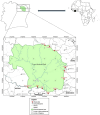Cultural attitudes and human pressure towards vultures around the Comoé National Park, Côte d'Ivoire (West Africa)
- PMID: 38419095
- PMCID: PMC10903046
- DOI: 10.1186/s13002-024-00657-0
Cultural attitudes and human pressure towards vultures around the Comoé National Park, Côte d'Ivoire (West Africa)
Abstract
Background: Populations of vultures in Africa have experienced a rapid decline over recent decades, with some species suffering losses of more than 90%. Various forms of human pressures have been identified as the causes of this decline. However, very little is known about the complex interaction between cultural practises, traditional medicine and the vultures' natural environment. The purpose of this study was to analyse human pressures on vultures in relation with cultural attitudes such as their demand for magico-traditional medicine in Côte d'Ivoire, around the Comoé National Park (CNP), one of the last major refuges of these organisms in West Africa.
Methods: Eleven surrounding villages were visited to carry out ethno-ornithology surveys. One hundred and ten people were interviewed, at a rate of ten people per village, using a semi-structured questionnaire and informal discussions.
Results: The findings showed that vultures are still being seen both in and around the CNP. The most common species indicated to be observed and indicated by the interviewees were the Hooded Vulture (Necrosyrtes monachus) and the White-headed Vulture (Trigonoceps occipitalis). Nevertheless, 98.2% of the interviewees indicated having observed a decrease in the abundance of vultures over the last few years in the study area, as well as a decline in the number of sightings of these organisms. Interviewees attributed this scarcity of vultures to (1) the limited availability of food resources, (2) pesticide and tobacco poisoning, (3) hunting, (4) rapid population growth, (5) annual bushfires and (6) habitat loss. The uses of the vulture or parts of vultures by the populations surrounding the CNP (traditional medicine, mystic practises, consumption as food, cultural heritage) were also highlighted as real threats to these organisms. And the vulture parts commonly used in this area are: feathers, legs, head, heart, stomach, brain and excrement. The Hooded Vulture (Necrosyrtes monachus) appears to be the most sought-after species and the most widely used for these practises in the study area.
Conclusion: Appropriate conservation and communication initiatives are required to ensure the survival of these raptors, crucial for ecosystem well-being, while also ensuring a respect of cultural practises.
Keywords: Comoé National Park; Côte d’Ivoire; Ethno-ornithology; Magico-traditional medicine; Vultures.
© 2024. The Author(s).
Conflict of interest statement
The authors declare that they have no competing interests.
Figures












Similar articles
-
Cultural significance and conservation challenges of the hooded vulture (Necrosyrtes monachus) and other vulture species in northeastern Benin.J Ethnobiol Ethnomed. 2025 Jul 22;21(1):51. doi: 10.1186/s13002-025-00806-z. J Ethnobiol Ethnomed. 2025. PMID: 40691828 Free PMC article.
-
Unveiling the Threat to Vulture Diversity: A Comprehensive Ethno-Ornithological Study Uncovers Regional Trade Effects in Côte d'Ivoire.Ecol Evol. 2024 Dec 23;14(12):e70740. doi: 10.1002/ece3.70740. eCollection 2024 Dec. Ecol Evol. 2024. PMID: 39720639 Free PMC article.
-
Not in wilderness: African vulture strongholds remain in areas with high human density.PLoS One. 2018 Jan 31;13(1):e0190594. doi: 10.1371/journal.pone.0190594. eCollection 2018. PLoS One. 2018. PMID: 29385172 Free PMC article.
-
Dropping dead: causes and consequences of vulture population declines worldwide.Ann N Y Acad Sci. 2012 Feb;1249:57-71. doi: 10.1111/j.1749-6632.2011.06293.x. Epub 2011 Dec 16. Ann N Y Acad Sci. 2012. PMID: 22175274 Review.
-
What do we know about lead contamination in wild vultures and condors? A review of decades of research.Sci Total Environ. 2019 Mar 1;654:409-417. doi: 10.1016/j.scitotenv.2018.11.099. Epub 2018 Nov 8. Sci Total Environ. 2019. PMID: 30447579 Review.
Cited by
-
Cultural significance and conservation challenges of the hooded vulture (Necrosyrtes monachus) and other vulture species in northeastern Benin.J Ethnobiol Ethnomed. 2025 Jul 22;21(1):51. doi: 10.1186/s13002-025-00806-z. J Ethnobiol Ethnomed. 2025. PMID: 40691828 Free PMC article.
-
Unveiling the Threat to Vulture Diversity: A Comprehensive Ethno-Ornithological Study Uncovers Regional Trade Effects in Côte d'Ivoire.Ecol Evol. 2024 Dec 23;14(12):e70740. doi: 10.1002/ece3.70740. eCollection 2024 Dec. Ecol Evol. 2024. PMID: 39720639 Free PMC article.
References
-
- Ogada D, Shaw P, Beyers RL, Buij R, Murn C, Thiollay J-M, Beale CM, Holdo RM, Pomeroy D, Baker N, Krüger SC, Botha A, Virani MZ, Monadjem A, Sinclair ARE. Another continental vulture crisis: Africa’s vultures collapsing toward extinction. Conserv Lett. 2016;9:89–97. doi: 10.1111/conl.12182. - DOI
-
- Botha AJ, Andevski J, Bowden CGR, Gudka M, Safford RJ, Tavares J, Williams NP. Multi-species action plan to conserve African-Eurasian vultures. CMS Raptors MOU Tech Publ. 2017;5:1–164.
-
- Thiollay J-M. Les rapaces d’une zone de contact savane-forêt en Côte-d’Ivoire: densite, dynamique et structure du peuplement. Alauda. 1975;43:387–416.
-
- Cook AW, Mundy PJ. Rüppell’s griffon vulture at Kotorkoshi, Nigeria. Malimbus. 1980;2:102–105.
-
- Thiollay J-M. The decline of raptors in West Africa: long-term assessment and the role of protected areas. Ibis. 2006;148:240–254. doi: 10.1111/j.1474-919X.2006.00531.x. - DOI
MeSH terms
Grants and funding
LinkOut - more resources
Full Text Sources

